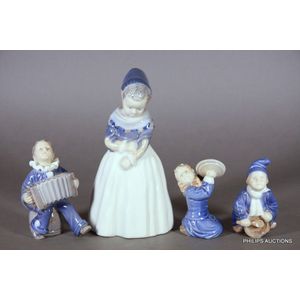Royal Crown Derby French Poodle Paperweight Ornament
You must be a subscriber, and be logged in to view price and dealer details.
Subscribe Now to view actual auction price for this item
When you subscribe, you have the option of setting the currency in which to display prices to $Au, $US, $NZ or Stg.
- Bone China - Bone china, Also called 'English china", is one of the three types of porcelain, the other two being soft paste porcelain and hard paste porcelain.
Porcelain is an ancient ceramic material, first made in China, hence the common name "china", and the introduction of bone china was to counter the imports of Chinese porcelain.
The initial development of bone china is credited to Josiah Spode, who introduced it around 1800 and it was soon after copied by other manufacturers including Minton, Coalport, Davenport, Derby, Worcester, Wedgwood and Rockingham and the Herculaneum factory at Liverpool.
Spode's bone china was made by mixing ash from cattle bones with feldspar and kaolin, which created a material that was stronger, more translucent, and whiter than traditional porcelain. He began to produce this new type of porcelain in 1796 and it quickly became very popular.
At the time, the process and ingredients were kept secret and were only known to a few manufacturers and were protected by patents.
In the 19th century, bone china became increasingly popular and was widely produced by many manufacturers in England. During this time, it was considered a luxury item and was often used to create fine dining sets and other decorative items.
Bone china is still used in the production of fine porcelain wares, such as tea sets, figurines, and other decorative pieces. His basic formula of six parts bone ash, four parts china stone, and three and a half parts china clay remains the standard English body. It is still considered a luxury item due to its strength, translucency, and whiteness, and is often used for high-end and high-quality porcelain. China. - Fleur-De-Lis - The fleur-de-lis is a stylized lily or iris flower with
three petals that has been used as a decorative motif for thousands of years. It
often appears in Christian iconography symbolising the Holy Trinity and as an
emblem that reflects the purity of the Virgin Mary. In decorative art and antiques
decoration, the fleur-de-lis is often used as a symbol of elegance, refinement,
and good taste.
The fleur-de-lis has a rich history and in ancient times, it
was associated with royalty, purity, and the divine, and it was used as a
symbol of the French monarchy for many centuries.
It is a common design element in ceramics, silverware, jewellery,
furniture, and other decorative objects, and it can be found in many different
styles and forms.
This item has been included into following indexes:
Visually similar items

A vintage trio of Royal Copenhagen musician children plus one other female figure in National dress, mid to later 20th century, comprising: 'The little Drummer', 3647; 'Girl and cymbals', 3677; 'Boy clown playing accordion' 3662, all with painter's initial

A Japanese carp vase, Meiji Period (1868-1912), decorated with gilt and pale blue enamel, the fish leaping from foaming waves. 29.5 cm high. Provenance: A Toorak Private Collection

A Neapolitan porcelain figural perfume bottle, circa 1860s finely modelled as a woman holding her cape and crinoline, with a skirt in floral and black striped patterns, and a puce and yellow bodice, the head serving as the stopper, blue Crown and N mark un

A Derby soft paste porcelain candlestick, 'Shepherd with Fruit and Flowers', 1760-65, model E29, the shepherd before a bocage wearing a pink waistcoat and lemon breeches, with a flower basket and a floral candle sconce, upon on a pierced rococo base with g
